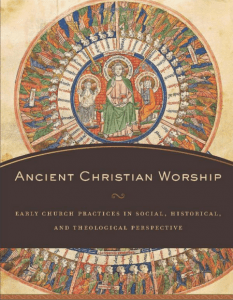 There are times when folks today are wearied by newness, by the next big thing, by each Sunday having to be a high, when the pastor has pull off the best sermon ever, when the musicians have to hit the right note and let it rock the whole place… when … many want to push a button and tell the church to slow down, to go quiet … when they want not to hear or experience something new but to be reminded of something true, something old, something with the taste of vintage sameness.
There are times when folks today are wearied by newness, by the next big thing, by each Sunday having to be a high, when the pastor has pull off the best sermon ever, when the musicians have to hit the right note and let it rock the whole place… when … many want to push a button and tell the church to slow down, to go quiet … when they want not to hear or experience something new but to be reminded of something true, something old, something with the taste of vintage sameness.
There are some prescriptions in the Christian tradition that seek to remind us of what matters most and to do so by ordering our worship to be reminded of that. This is not the nostalgic kind of remembering but the brushing up against the verities of the faith kind of remembering.
Then Paul Bradshaw, at Notre Dame, says “This is the book that I wish I had written, but Andrew McGowan has done it so much better” and Robin Jensen, at Vanderbilt, says “Andrew McGowan here provides a clear and beautifully written introduction to ancient Christian worship. While never oversimplifying the richness and complexity of his subject, McGowan has produced a study that is simultaneously comprehensive and accessible.” These are people who know the history and aesthetic of worship, and they say this book gets to the heart of earliest Christian worship.
The book about which they write is Andrew McGowan’s Ancient Christian Worship: Early Church Practices in Social, Historical, and Theological Perspective (Baker, 2014). What are the major elements of ancient Christian worship? [One might ask What are the major acts of worship?]
1. Meal: banquet and eucharist
2. Word: reading and preaching
3. Music: song and dance
4. Initiation: baptism, anointing, and foot washing
5. Prayer: hours, ways, and texts
6. Time: feasts and fasts
The “trick,” if I may use the wrong word for the moment, is balancing these so they tilt us all in the right direction: toward God in Christ through the Spirit so that we become the people of God of all time for our time. McGowan is not offering a program and it would be a mistake to turn these into a program. These are age-worn paths that alone take us to the heart of the gospel because they seek to embody that gospel. The more of these your church lacks, the more your church will be a trendy thing that will find its way to the next trendy thing. The more of these your church has the more likely your church can be located in the paths that lead to the kind of communal formation that pleases God.
In spite of what many say today about liturgical formation, suggesting far too easily that doing the right practices will yield both the right character and the right church, these ancient elements of ancient Christian worship must be prompted by the Spirit (and the Spirit invoked) and the individual Christian must respond in faith and love and the local church needs to open itself as a Body to the work of God in Christ through the Spirit. Practice without Spirit and faith deforms the Christian and the church; Spirit and faith without practice produce anarchy and will not form the Christian or the church.
We might observe what McGowan observes: the word “worship” has its own problems of meaning in our context.
Today “worship” can often mean communal prayer and ritual, as it will be used for the most part in this book; but for some, “worship” is more like a personal belief or orientation, which is inward in essence, if necessarily expressed in outward and communal forms. In some parts of contemporary Christianity, however, “worship” means a particular genre of music, often used in gatherings (as in the first definition) but intended to express and affirm personal devotion (as in the second). If the last of these definitions is most strikingly specific or even idiosyncratic, all of these uses are actually quite modern; not very long ago, “worship” meant something rather different (2).
How is the term “worship” used in your circles?
The old meaning of worship was about acts that created a world ordered before God; it was about the whole of service or devotion. Worship is about the body and about the ordered service enacted in that body.
A noticeable shift has occurred: “The old is about embodied life and ethics, the new about inner life and aesthetics” (4). Notice this about the NT use of “worship” (latreia): “‘Worship’ language in the NT texts suggests a great deal about ethos or a Christian way of life, but relatively little about the specifics of distinctive liturgical practice or performance” (7). I find this kind of language both helpful and unhelpful because it tends not to exclude but to include so much one wonders if what we thought was excluded has been given back.
So McGowan now defines worship: “In this book, ‘worship’ henceforth means these practices that constitute Christian communal and ritual life, as reflected in the NT itself and thereafter, not merely or specifically what the NT itself calls ‘worship’ (7; italics added).
Join us in this series on finding the quiet sameness of ancient worship, ever new since it orders us ever yet before God in Christ through the Spirit.










